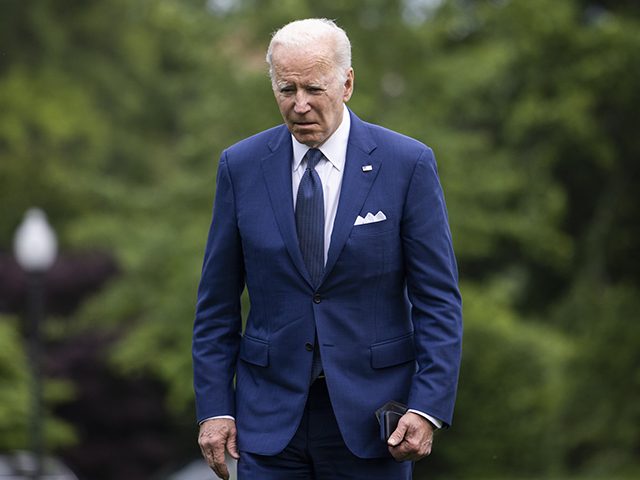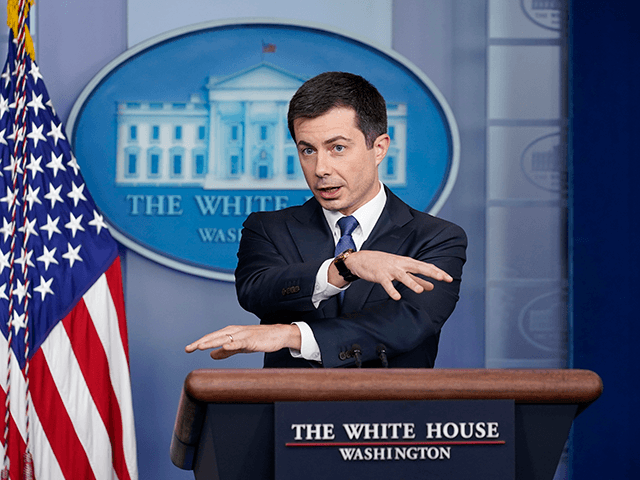
An explosive new analysis published by the Committee to Unleash Prosperity reveals that Democrat President Joe Biden’s administration has very few business-oriented officials in the administration and that the vast majority of people handling economic policy for the United States government under Biden have no business experience whatsoever.
The 15-page report, authored by economist Steve Moore and the Committee to Unleash Prosperity‘s executive director Jon Decker, was provided to Breitbart News exclusively ahead of its public release. The headline of the report is: “Not Ready for Prime Time Players: Majority of Biden Appointees have Zero Years of Business Experience.” The report analyzes the backgrounds of the “top 68 officials in the Biden administration, starting with the president himself, and including cabinet members, regulatory officials, and White House advisers.”
In the executive summary, the authors detail some key findings in the report. First and foremost, 62 percent of Biden’s top political appointees and staffers “who deal with economic policy, regulation, commerce, energy and finance have virtually no business experience.”
What’s more, only one out of eight Biden officials has what the authors deem “extensive business experience,” and the average level of business experience across the Biden administration is about 2.4 years. The median years of business experience among Biden’s top appointees is zero, since so few have any experience in the private sector, and the “vast majority of the Biden economic/commerce team members are professional politicians, lawyers, community organizers, lobbyists, or government employees.”
The appendix of the report lists out each of the 68 officials analyzed, starting with both President Biden and Vice President Kamala Harris. Both of them each have zero years of business experience. Attorney General Merrick Garland also has zero years of business experience, and Secretary of Agriculture Tom Vilsack has zero years as well. Treasury Secretary Janet Yellen, Secretary of Veterans Affairs Denis McDonough, Secretary of Homeland Security Alejandro Mayorkas, Secretary of Labor Marty Walsh, Secretary of Health and Human Services Xavier Becerra, Secretary of Housing and Urban Development Marcia Fudge, Ambassador for Climate Change John Kerry, Office of Management and Budget director Shalanda Young, Secretary of Eduction Miguel Cardona, U.S. Trade Representative Katherine Tai, and many, many more have zero years of business experience.
In Biden’s Cabinet and innermost circle, White House Chief of Staff Ron Klain with 16 years, Secretary of Interior Deb Haaland with 11 years, and Secretary of Commerce Gina Raimondo with 11 years, have the most business experience close to the president. Isabel Guzman, the administrator of the Small Business Administration, has the most business experience of those analyzed with 20 years experience.
Secretary of Transportation Pete Buttigieg has just four years of business experience. The report authors note his business experience has not much to do with his Department as “he has virtually no experience in transportation or logistics.”
As compared with former President Donald Trump’s cabinet during his last year in office, the lack of private sector business experience in the Biden administration is stark. Trump’s team, per the authors, had an average of 13 years of business experience with a median years of experience of eight.
This report comes as inflation numbers announced earlier on Wednesday hit their highest levels in 40 years, with an annual rate rise of the Consumer Price Index (CPI) much higher than expected at 9.1 percent per the Department of Labor.
“As the United States battles the highest inflation rate in four decades; a stock market sell-off that has liquidated some $10 trillion of wealth and retirement savings; and fast-declining consumer, small business, and investor confidence; and there is widespread concern that America is in a recession or teetering on the verge of recession. For the first half of 2022, the economic growth rate has been negative, according to the latest forecast from the Atlanta Federal Reserve Board,” the study says. “Americans are deeply divided on the Biden administration’s progressive economic policy priorities: the focus on redistribution of income, higher tax rates on the rich, more social welfare programs, pro-union policies, a heavier hand of regulation of business, government-directed investment, and climate change remedies aimed at a dramatic altering of America’s energy mix. But putting ideology and partisan leanings aside, a new concern of voters has emerged: Do the top decision makers in Congress and the Biden administration have the basic skill sets and business/ management experience and acumen to oversee a $6 trillion federal government and to regulate our multi-trillion dollar industries? Polls show Americans are generally unhappy with the economic direction of the country today.”
The report also notes that many of the officials who do have some business experience in some respect—like Buttigieg—are not working in a field they are familiar with.
“The list of Biden administration officials that we compile in this report starts at the top with the resumes of the President and the Vice President,” the report authors write. “We also examine 68 of the top political appointees of the Biden administration, including his cabinet officers (who deal with domestic policy issues), the commissioners of the major influential regulatory agencies, and other high-ranking White House policy-making personnel.”
On a key findings page, several more statistics are revealed. Across all 68 top Biden officials in total there are just 161 years of business experience, and 42 of them have “virtually no business experience whatsoever.”
What’s more, the primary field of most of these Biden officials is one of the following three categories: politics and government, law, or academia and policy. Twenty-one of the 68 come from politics and government, 20 of them come from law, and 12 of them come from academia. Three come from a category called “consulting/public relations,” five from “venture capital/investments,” four from “education/health,” two from “miscellaneous business,” and one from “labor.”
“What is the takeaway from these findings? Surely we want our political class to have a diversity of backgrounds,” the authors write. “We want lawyers, grassroots activists, those with political and policy experience, scientists, health experts, and academics with required specialties. But we also want people who have experience running large operations with hundreds and thousands of employees and who understand logistics. We want people who know how to cut costs, manage logistics, increase productivity, meet payroll, and make a profit (or in the case of the government, avoid large losses). We need people at the top rungs of government who have experience dealing with large-scale crises (as we experienced during COVID), and also at least some familiarity with the everyday struggles that businesses have with the government.”
But it seems, the report authors note, that Biden’s focus on making “diversity” a major hiring “goal of its administration,” the U.S. government is now falling short when it comes to actually having people who know what they are doing with the economy in charge of economic policy. The authors note that “the one area that is sorely missing in this diversity goal is in attracting talented and experienced men and women from the field of small business, commerce, and finance.”
“When it comes to the government: Ignorance is not bliss,” the authors write. “These skills are sorely lacking in the Biden administration. The cascade of policy and management mistakes that are piling up in the Biden government are at least in part a consequence of this lack of basic skills and competency. Biden should fix the problem by replacing those chosen for their ideology, not the skills and talents our government needs and taxpayers rightly demand.”
Shipping Crisis Turns Into A Nightmare As Disruptions Aggravate Container Shortage
Pete Buttigieg Boasts that High Gas Prices Are Forcing Americans Towards Electric Vehicles

President Joe Biden’s Transportation Secretary, Pete Buttigieg, boasted about how high gas prices are forcing Americans towards electric vehicles during an interview on Thursday on REAL 92.3’s Big Boy TV.
Buttigieg said:
We’re for cutting the cost of electric vehicles because when you have an electric vehicle, then you’re also going to be able to save on gas, but you got to be able to afford it in the first place. Right now, we’re actually starting to see on some models the costs come to where even if your car payment’s a little higher, your gas payment will be a little lower, and you come out ahead, but the prices still need to come down for most Americans to be able to get an EV.
Buttigieg’s comments come as recent U.S. Labor Department data found the annual inflation rate rose to a massive 9.1 percent in June. In addition, Americans are paying record-high gas prices under Biden’s administration.
One day after Buttigieg’s remarks, electric vehicle manufacturer Tesla reportedly asked Texas drivers to avoid charging their vehicles for five hours out of the day due to a heatwave.
“A heat wave is expected to impact the grid in Texas over the next few days. The grid operator recommends to avoid charging during peak hours between 3pm and 8pm, if possible, to help statewide efforts to manage demand,” the Tesla alert sent to customers’ in-car screens said.
Buttigieg’s comments on Thursday are not the first time he’s promoted expensive electric vehicles as a way for American consumers to save on gas expenses. The Transportation Secretary said, “People from rural, to suburban, to urban communities can all benefit from the gas savings of driving an EV,” in March after gas prices broke a record previously set in 2008.
Buttigieg made a similar comment in November during an interview with MSNBC.
“The people who stand to benefit most from owning an EV are often rural residents, who have the longest distances to drive, they often burn the most gas,” he claimed.
Buttigieg’s statements seem to represent the Biden administration’s official position on gas prices, as other members of the administration have promoted switching to electric vehicles in the wake of skyrocketing gas prices.
Last month, Biden’s Energy Secretary, Jennifer Granholm, claimed that American gas prices are “unsustainable,” but noted that the high costs are “accelerating our progress toward clean energy.”
Granholm also said that high gas prices make a “very compelling case” to purchase electric vehicles.
“If you filled up your EV and you filled up your gas tank with gasoline, you would save $60 per fill-up by going electric rather than using gasoline but it’s a very compelling case, but again, we want to bring down the price at the point of purchase,” Granholm said.
No comments:
Post a Comment